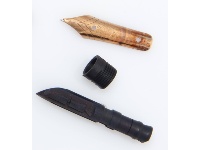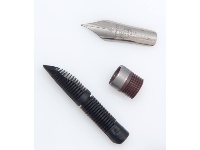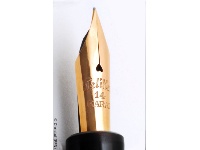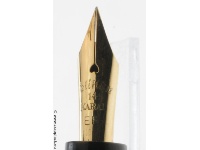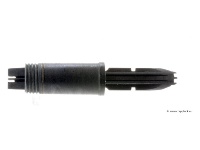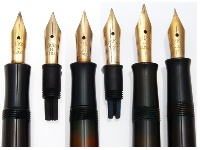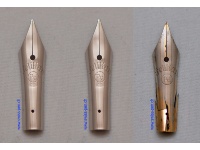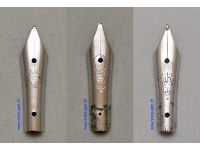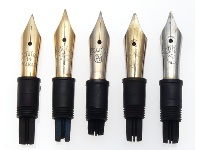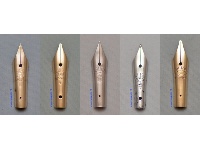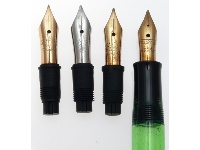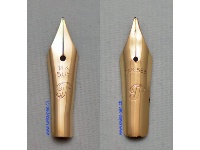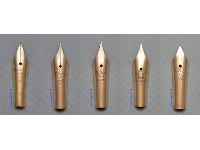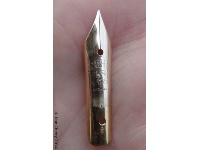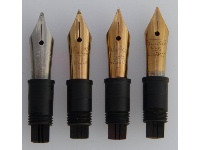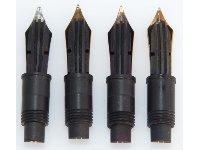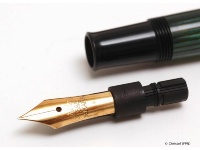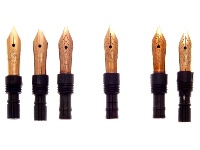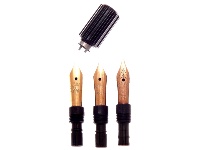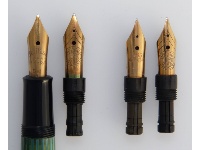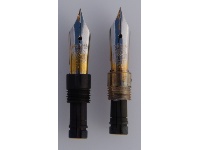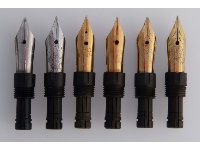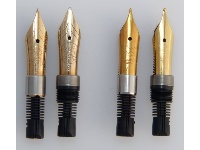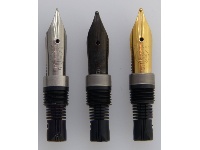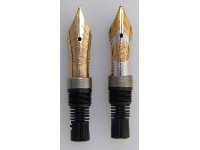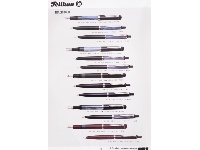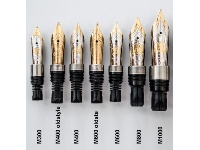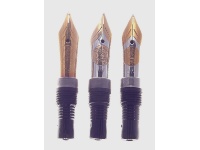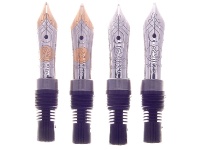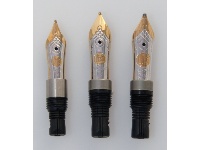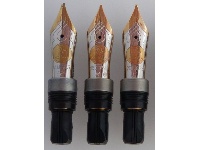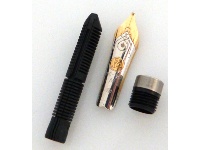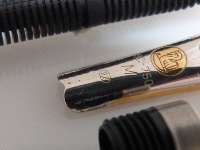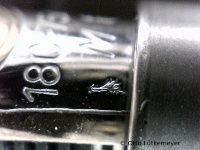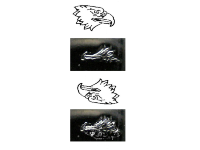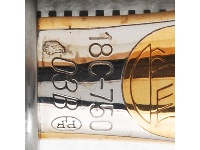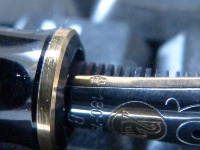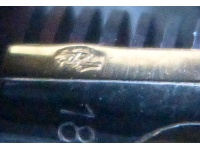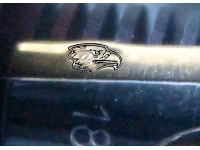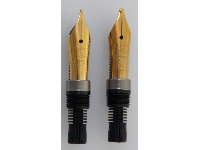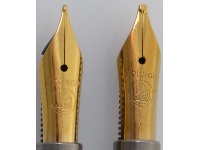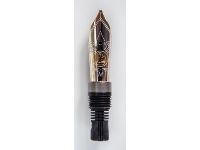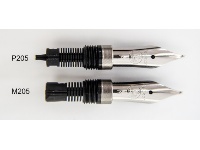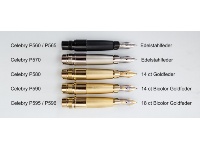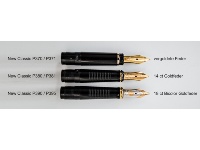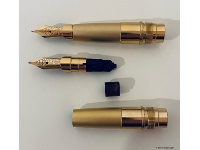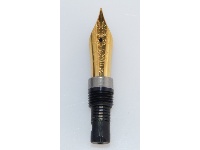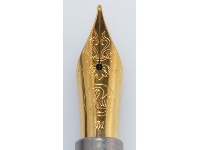- Nib units
- Model 1929
- Series 100 and 100N
- Nib-width specifications and manufacturer markers
- Special nib embossings
- Early 18 carat nibs
- Model Rappen
- Model IBIS
- Model series 400/400N/400NN
- Nib removal tool
- Special nibs
- Model series 120 and 140
- Models made by Merz & Krell (400NN / 120)
- Restart with the Sovereign and Classic series
- Nibs with E|N and PF stamps or punches
- The logo on the nib
- Model Majesty
- Cartridge pens P200 / P205
- Cartridge pens New Classic and Celebry
- Cartridge pens Epoch and Ductus
- Limited Editions and Special Editions
Nib units
The very first Pelikan fountain pen in 1929 was already equipped with a nib unit consisting of an ink feed, the metal nib and a bush which holds these three parts together.
The bush has an external thread, enabling the nib assembly to be screwed into the internal thread of the grip section in the fountain pen.
Model 1929
The hearthole nib is found in the first Pelikan fountain pen from 1929.These nibs can be found both with and without a stamped nib width. Later the hearthole was replaced by a circular air hole.
Since Pelikan had not yet been able to produce its own nibs at the beginning of its fountain pen production, the nibs were purchased from Montblanc. Pelikan has been producing gold nibs itself since 1934.
The bush had a length of 17 mm until mid-1931; it was then shortened to 12 mm. This dimension was maintained over the 100 series.
Series 100 and 100N
The nibs of the Pelikan 100 differ in various small details. A big change was accomplished in 1937. With the introduction of the model 100N, the embossing of 14 KARAT was changed to the additional specification 585 - 14 KARAT. The nib of model 100 is slightly smaller than the model 100N nib.
Because the production of gold nibs was then prohibited, palladium nibs were used from 16 May 1938 to 10 February 1940. These bear the imprint PD.
Starting from 1939 also chromium-nickel steel nibs were also used. They are embossed with the letters CN. These nibs were later also used in models 140 and 400. There is in principle no difference in the quality of the writing experience of these nibs compared to the gold nibs.
Nib imprints Pelikan 100
The nibs of the Pelikan 100 model vary in detail. Embossing the number 14 with dashes or dots are examples. The main changes to the stamped details are as follows:
- 1930-1937 "Pelikan" spotted, "14", "KARAT" A with serifs
- From 1937 "Pelikan" spotted, "585", "14 KARAT" A with serifs
- 1938-1940 PD
- From 1939 CN
Nib embossing Pelikan Model 100N
The Pelikan 100N model was introduced in 1937, initially for export only. The production of the model 100N and 100 ran parallel until 1944 (the year in which the 100 was discontinued). Therefore the nib stampings on the 100N are similar to those of the model 100 in the same period. The following imprints can be found on the nibs of the model Pelikan 100N:
- 1937 old "Pelikan" thinly spotted, "585", "14 KARAT" A without serif
- 1937-40 "Pelikan" medium point, "585", "14 KARAT" A with serifs
- 1938-1940 PD
- From 1939 CN
- From 1940 "Pelikan" smooth, "585", "14 KARAT" A without serif
Gold nibs were offered again in Germany from July 4, 1949, for the 100N model.
For special applications, such as those of the manifold pens for the Taylorix accounting method, there were correspondingly embossed nibs.
Nib-width specifications and manufacturer markers
The nib widths were sometimes embossed on the nib itself, sometimes impressed on the ink feeder and sometimes engraved on the filling knob.
In addition, there are different characters which can be found on the nib or the ink feed. These are e.g. stars, circles, minus signs, and plus signs, which obviously marked the material supplier of the metal, allowing Pelikan to determine the origin of the starting material. These markings are also found on the cap ring in the later models, e.g. Pelikan 400.
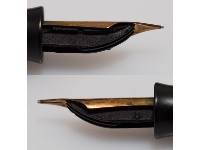
Nib size and manufacturer marker on the feeder
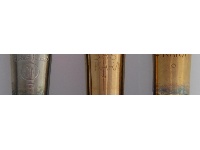
Manufacturer markers on nibs
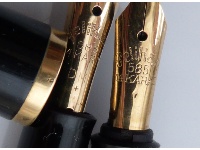
Manufacturer markers on model 400
Special nib embossings
In addition to the conventional nib markings shown above, there are some special embossings, e.g. the letters G.W. (for Günther Wagner). The production of these nibs is attributed to the plant in Vienna.
A single "P" is also found, of which we do not know the background, as well as nibs with double border of the lettering Pelikan.
The "P" was registered as a Swiss responsibility mark by Pelikan in December 1957.
Early 18 carat nibs
For the models 100 / 100N and later 400 nibs of 18 ct gold can also be found, which were manufactured by Pelikan. This had become necessary for export to France, since nibs with a lower gold content could not be offered as "gold nibs", there.
Model Rappen
From 1932, the Pelikan Rappen was offered as a cheap pump-filler fountain pen.
In the course of time changes were made in the embossing of the nib. In addition.
The first nib imprint had the embossing GARANTIERT 14 KARAT. The two following nibs can be seen in the photo.
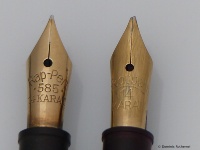
Two Rappen nibs, left since 1937, right before 1937
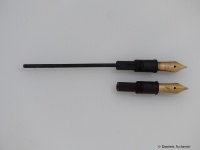
Rappen ink feeder with tube
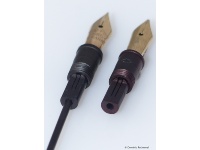
Rappen ink feeder with receptacle for the tube
Model IBIS
The IBIS fountain pen also had nibs made of steel (CN), gold and palladium (PD) with various embossings. The IBIS was used as a forerunner for the PD nib, which had been in use since February 19, 1937. The CN nib was used in the IBIS from 1939 due to material restrictions.
Model series 400/400N/400NN
The first fountain pens of the model Pelikan 400, which came onto the market on 25th of May, 1950, were equipped with plug-in nib unit. There is no thread on the bush. The nib unit thus holds purely by frictional force. The plug-in nibs were used until August 1950, after which time a nib unit with a thread was reintroduced.
Finding fountain pens with plug-in nib unit is a rare hit. It is a fallacy that whenever the nib assembly cannot be completely extracted, and the nib and feeder are held in the hand while the bush remains in the fountain pen, such a pen has been found. This fallacy should be easily clarified by looking at the photo, since in this case the bush is missing, which is also present with the plug-in nib unit.
There is a Pelikan 100N known with a plug-in nib unit. Since the first models of the Pelikan 400 were produced at the beginning of the 1950s with a plug-in nib unit, the corresponding prototypes or small runs are not unlikely in the model 100N.
Otherwise the metal nib of the model 400 was identical to the nib of the model 100N and did not carry a nib width designation until April 1952.
From December 1954 the so-called fir tree nibs were already used in model 400, these nibs show the Pelikan logo and have lines which meet at the nib slot. The lines resemble a stylized Christmas tree, hence the nickname fir tree nibs.
The model 400N, which was only produced in 1956, has been delivered exclusively with this fir tree nib.
The model 400NN, with which the lines of the fir tree meet at the nib slot, also started with the fir tree nibs. In 1964, shortly before the production of the model 400NN was discontinued in the year 1965, the nib was modified and the lines now ended shortly before the nib slot.
Beware of confusion: this is the design with which the Souverän series started in 1982 with the M400, too. But here the pen width was embossed in italics.
Nib removal tool
For the uncomplicated and gentle unscrewing of the nib units, a simple, ingenious principle was introduced with the screw-nib units of the model 400. The bush has two notches into which a nib removal tool can slot in order to avoid putting pressure on the nib or the ink feed while unscrewing the unit.
The principle was also applied to the nib units like those of models 120 and 140 and the same tool can be used.
However, this idea led to patent disputes with Montblanc,though these were eventually settled.
Special nibs
The special nibs for various fields of application include steno nibs, which require a little flexibility with a very fine nib and a good ink flow. However, the nib does not differ visually from the usual nibs of other widths.
Music nibs with a lot of flexibility with two air holes and two nib slits are a nib that should be specially recognised.
Another, widely used special nib is made for manifold (making carbon copies). For this purpose Pelikan started by making regular nibs more rigid, but they didn't differ visually from other nib widths. The nib width is denoted by D, followed by the width (DEF (Geman: Durchschreibefeder = Manifold, ExtraFine), DF, DM and DOM are common. Like the other nib widths imprints, the nib width was not always marked on the nib itself. Often, the nib width is only found at the barrrels end.
Simultaneously with the introduction of the nibs with the Pelikan logo in December 1954, the manifold nibs also show a specific visual characteristic; the nibs have a second air hole. The second air hole is much closer to the tip of the nib and the nib slit ends there, making the nib very hard and rigid. As a result, the nibs do not bend even when pressing hard. The solid pressure made possible allows carbon copies to be made easily.
Manifold nibs were necessary for accounting systems such as Taylorix, LEOMA and RUF accounting. On orders produced for these companies, the fountain pens and nibs did not receive any Pelikan marks. The third nib from the left on the image below comes from the Model 140 for RUF accounting.
Model series 120 and 140
The nib size of the fountain pens 120 and 140 is identical. Compared to the simultaneously distributed models of the 400 series, the nibs and ink feeders are smaller.
The Pelikan 120 school fountain pen has a steel nib with the widths EF, F, M, ST, O or PF. The ink feed is made of ebonite with 4 longitudinal fins.
At times, the bush was also made from ebonite (black) and later from polypropylene (transparent plastic). This easily becomes brittle and is now almost always defective. In some cases, the defective bush is stuck in the fountain pen, which makes a repair more difficult.
The Pelikan models 140 usually have a gold nib and also an ebonite ink feeder with 4 longitudinal fins. As with the model 120, the model 140 also has polypropylene bushings.
The nibs of the model 140 were produced with the following imprints:
- Before 1954: "Pelikan" (smooth lettering), "585", "14 KARAT" (A without serif)
- After 1954: Fir tree lines go to the slot, "Pelikan 14 C 585" (in round logo)
- From 1964: Fir tree lines stop before the slot, "Pelikan 14 C 585" (in round logo)
- Chrome-Nickel (CN) nibs: CN in a circle
Models made by Merz & Krell (400NN / 120)
After 1965, Pelikan produced only "modern, streamlined" fountain pens with internal ink feeds and plug-in nibs.
When Pelikan realized that there was still a demand for the old models with a gold or steel nib, especially for the Japanese market, Merz & Krell commissioned to make the Pelikan 400NN and Pelikan 120 models.
With small deviations from the original, the model 120 and the model 400NN were manufactured by Merz & Krell in the years 1973 to 1977.
The 400NN's nib unit even got an ebonite ink feed similar to the original, while the Pelikan 120 had a plastic ink feed.
Both nib units have a non-standard screw thread for Pelikan, which is not compatible with the earlier models.
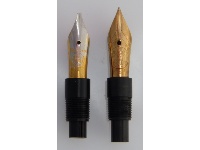
Front view of the nib units M&K 120 and M&K 400NN
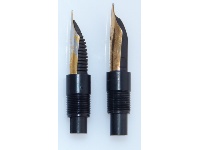
Side view nib unit M&K 120 and M&K 400NN
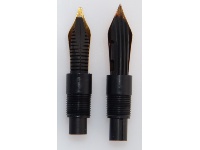
Rear view nib unit M&K 120 and M&K 400NN
Restart with the Sovereign and Classic series
In 1982, the Pelikan M400 launched a new version of fountain pens based on the old Pelikan 400 model. These models were later assigned to the Souverän series (from 1987). All fountain pens in this series were equipped with gold nibs.
One year later, in 1983, the M481 model is equipped with a gold-plated steel nib for the low-price market. This model can be viewed as the predecessor of the M200 model, which is assigned to the Classic series.
All ink feeds of these model series were now no longer made of ebonite, but made of plastic and with transverse instead of longitudinal fins.
The first models of both series were equipped with a plug-in nib unit, which was replaced by a screwed nib unit after a short time. These series are still being produced with these screwed units.
In the Classic range, with the models M100, M150, M200 and M481, nib units are usually delivered with stainless steel nibs or gold-plated stainless steel nibs. The M250 models, on the other hand, are equipped with a 14 ct gold nibs as standard.
The M100 White was supplied with a black anodized stainless steel nib.
However, models are also known for special orders or occasions, where nibs were used which were not provided in the standard model.
The Pelikan M481 was also available with 12 ct Bicolor gold nib, made for the Japanese market. On the other hand, the Pelikan M481 was used as a gift for special occasions. The M200 / M250 with 12 ct Bicolor gold nib was also sold in Japan as model number # 350, often in the nib type (HF or HM - hard fine or hard medium).
In the middle of the nineties the German department store Galeria Kaufhof sold in a small series an M250 in Tortoise brown-striped with bicolor gold nib (nib as in the M400). Galeria Kaufhof also offered an M250 in black with bicolor gold nib (as in the model M600 old style). The otherwise completely identical model from Pelikan had a monochrome gold nib.
In addition to the familiar specials delivered from the factory, every Pelikan owner has the opportunity to change the nib units of the models M481, M200, M250, M400, M450, M450, M600 old style, M700, M750, M760 arbitrarily. Thus, there are many alternative, individual combinations of nibs and fountain pens which were not actually produced in the original series.
In addition, it is also possible to screw these nibs into the fountain pen models M100, M150 and the modern M600. With these models, however, the nib itself is slightly smaller (M100, M150) or slightly larger (in the modern M600).
The M300, M800 and M1000 model families have individual thread sizes, which means that the nibs are not interchangeable with other models.
The Sovereign series is intended for the high-price market and therefore is basically always equipped with a gold nib. In the beginning, only monochrome gold nibs were present; nowadays bicolor gold nibs or fully rhodium-plated gold nibs are often found in the fountain pens.
The first models M400 all had a single-color 14 ct gold nib. From 1997 these were replaced as standard by a 14 ct bicolor gold nib. The models M405 with silver-colored fittings also carried these bicolor nibs. It was not until 2015 that Pelikan equipped this model series with a fully rhodium-plated 14 ct gold nib.
The higher-priced model Pelikan M600 (Old Style), which was built from 1985, did not differ in size from the model M400, but it distinguished itself by adding further decorative rings on the barrel and the cap initially also by a single-color 18 ct gold nib. The nibs used in this model have, however, undergone an interesting development over the course of time.
From 1988 at the latest, 14 ct bicolor gold nib was used, and from 1990 an 18 ct bicolor gold nib was used.
Since 1997, the M600 has been manufactured in a somewhat larger form. The size of the nib unit has also been extended and now a 14 ct bicolor gold nib is installed as standard.
The largest fountain pen from Pelikan can be found in the M800 and M1000 series.
Apart from the first years of production of the model M800 (Old Style) 18 ct bicolor gold nibs are installed today as standard. After the Limited Edtion Gaudi in 2002, the demonstrator M1005, released 2011, carried a fully rhodium-plated gold nib. Since 2015, this style of nib has now become the standard for all pens with silver-colored fittings.
However, numerous exceptions to the rules are also known for all of these model series M300 - M600.
For the M300 and M600 models, upgraded fountain pens with an 18 ct gold nib are available. In the models Toledo, fountain pen with vermeil cap or numerous special editions such as the grand places or the city series.
In the M800 model, 14 ct nibs were initially used (which today are much sought after as they are said to be more flexible) and later 18 ct nibs were introduced.
Pelikan has also produced a 20 ct nib for the M800 model. This was officially used in a second edition of the Toledo (M900), but was also used in a jubilee fountain pen celebrating the 120th anniversary of the Japanese bookstore chain Maruzen The Fountain pen was available in two versions, the standard model M800 (Old Style) black and green-striped, in the barrel was engraved "Celebrating 120th MARUZEN and 1869-1989".
Possibly the nib was elsewhere offered on the Asian market.
Nibs with E|N and PF stamps or punches
On some nibs, there are punches, which have partly led to wild speculations and myths.
The punches E|N and PF were partly embossed on the non-visible part of the nib, which is hidden by the bush. This applies to both historical and modern nibs. These stamps can already be found on the gold nibs of the models 100 / 100N and 400, if they were made of 18 carat gold.
These marks are easier to discover, of course, when they are placed in the visible area of the nib. This is the case for many modern nibs of the M600 Old Style, M800 and M1000 series.
The stamp with the characters PF is probably a responsibility mark according to the former E|N stamp. The responsibility brand must be registered by the manufacturers and be affixed to gold products. We actually don't know for what country or regulations this was necessary after 1994. The PF hallmark can also be found on the gold barrel of the Original of their Time 101N Gold from 1997.
In Switzerland there are also regulations what make a responsibility mark necessary. For this market, Pelikan registered some Logos and Symbols as responisibility mark so the Pelikan Logo itself is registered and e.g. the LEVEL lettering. You can find the registered responsibility marks for Pelikan here.
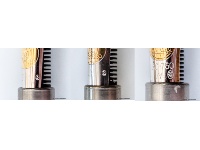
Pelikan M600 (OS), M760 and M800 with punches
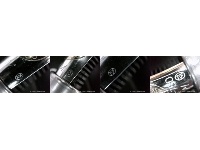
Pelikan M600 (OS), M750, M760 and M800 with punches
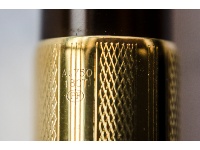
PF hallmark on a gold barrel
The stamp with the signs E|N were installed by Pelikan until about 1994 on 18 carat gold nibs.
In addition, some pens have punches or other symbols, some of which look like a damage or a material defect. These are so-called control stamps, which were applied by customs at the time of importation. The picture below presumably from the French customs, where this practice was carried out on nibs until 1994.
On 4th of January, 1994, the Code général des impôts - Article 532 had been abolished. Before the exemption limit in gold was only 0.5 grams, until 2001 it was 1 grams and from that time it is now 3 grams of gold.
A French "Bureau de la garantie" has confirmed that the nib shown below bears an importer punch with the symbol of the earth with the initials TK, as well as a guarantee mark from Strasbourg (the curculionidae) for 750/1000 respectively 18 ct gold.
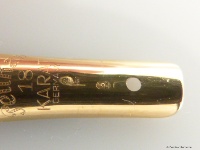
Nib with an importer punch (TK and symbol of the earth) and test mark (curculionidae)
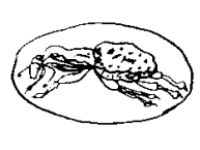
Curculionidae (french: charançon) test mark for 750/1000 gold (18 ct) - used between 1919 and 1993.
Nibs with corresponding stamps are more popular with some collectors. This is mainly due to the fact that the approximate production period can be read from it and more recent nibs are considered to be potentially more rigid in use.
Like material errors, the more modern control stamps with the eagle head looks as well. The eagle head is the small control mark of the French customs for 750/1000 Gold.
Apparently, the nib of the modern M6xx series with 18 ct gold has a share of (over) one gram of pure gold. The nibs intended for France were also given the appropriate control stamp, but elsewhere than it is known from the M800 nibs.
The logo on the nib
The change of the Pelikan logo in 2003 with the reduction of the number of chicks in the nest from two to one is also visible on the logo on the nib.
However, Pelikan continued to use the metal tools for stamping and embossing as long as they do not show any defects or wear. This explains why the nibs of modern fountain pens were delivered with two chicks for a long time after 2003.
Model Majesty
With the models Majesty M7000 and M7005, Pelikan has created the most valuable series fountain pen, whose production was not limited by time or quantity. The noble writing instruments adorn an 18 ct bicolor gold nib with its own specific engraving design. Although the size of the Majesty is comparable to that of an M800 pen, the size of the Majesty's nib corresponds to that of the M600 model.
Cartridge pens P200 / P205
The cartridge fountain pens P200 and P205 correspond to the design of the piston fountain pen series M200 Classic. The nib assemblies also have the same thread and would in principle be interchangeable. However, since the ink feed of the nib unit of the P200 / P205 has a mandrel for piercing the cartridges, the P200 / P205 model cannot be used with a nib unit for a piston fountain pen.
Cartridge pens New Classic and Celebry
The New Classic (from 1992) and Celebry (from 1997) models are another special design feature. Here, it is not intended to remove the nib unit from the front grip section, even if disassembly is technically possible. Depending on the model type, these grip sections and the installed nib differ.
Cartridge pens Epoch and Ductus
The nib assemblies of the cartridge pens Epoch and Ductus differ from the nib assemblies shown to date. The unit completely encapsulates the ink feed at the end that is screwed into the grip section so that the ink feed is only visible directly under the nib. This end of the nib assembly also includes a mandrel and a sealing ring for piercing and sealing the ink cartridges. After screwing into the grip section, a part of the unit remains visible.
The nib assemblies of the Epoch and Ductus have the same sizes and threads. Only the sizes of nib and ink feed differ. Both parts are longer in the Ductus. So a nib unit of the Epoch can be used in the Ductus, but this is not possible in the opposite direction, since otherwise the cap of the Epoch cannot be closed because of the longer nib.
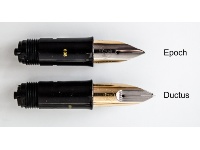
Comparison nib units Epoch and Ductus
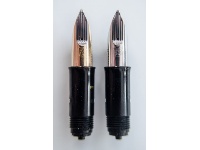
Nib units Ductus P3110 and P3100
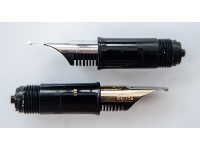
Side view of the nib units from Ductus
Limited Editions and Special Editions
For some limited and special editions the nibs from the series models were used, sometimes with a higher gold proportion. However, there are also a number of Limited and Special Editions for which a special engraving design was used.
For the M101 and M101N, the nib was manufactured according to the historical model. Nevertheless, the dimensions of the ink feed and bush are adapted from the modern production series.
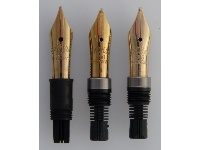
Nib unit (Pelikan 100 (original), M101 and M101N)
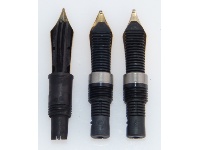
Rear view/ink feeder (Pelikan 100 (original), M101 and M101N)
The nib of the model M120N is shown here as an example of an individual design of a nib. This chasing has not yet been used on nibs and is based on design elements from a historical Pelikan catalog of 1889.
For a good exchange the forum The Fountain Pen Network - FPN.


